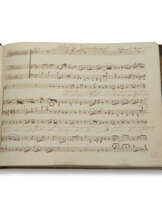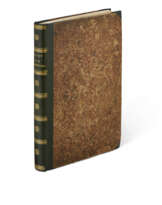ID 1053201
Lot 87 | Joseph Haydn (1732-1809)
Estimate value
£ 60 000 – 90 000
Autograph music manuscript, performance parts for Symphony no 90 in C major, Hob.I:90, n.d. [c.1788]
The lost autograph source for the trumpet and timpani parts of Haydn’s Symphony no 90, as published in the authentic London edition of 1791. The only autograph manuscript for a symphony by Haydn, the father of the form, to have appeared at international auction (RBH).
Trumpet and timpani parts for the complete symphony, notated in brown ink on five systems of two staves, on four pages, 230 x 320mm, of a bifolium ruled with 10 staves per page, Austrian paper (partial watermark: three crescent moons and the countermark ‘VA’, presumably originally beneath a crown, i.e. Tyson WM Nr 95), with autograph instrumentation (‘2 Clarini/Tympani’), movement and tempo markings along with scattered autograph emendations and cancellations, paginated ’68-71’ in another hand, annotated in a 20th-century hand at the head (‘Autog. D’Haydn’) and foot (‘Partie d'orchestre d'une symphonie (trompettes et timbales)’ of p.1 and ‘Haydn’ on p.2. In a 21st-century quarter-morocco green cloth folder with gilt-lettered label.
Provenance:
(1) Presumably held in a French collection in the 20th century, during which time the annotations to page 1 were made.
(2) Sotheby’s, 4 December 2007, lot 59.
(3) Schøyen Collection, MS 5402.
Haydn arrived in London at the beginning of 1791 with relatively few new works to his name; his contract with Johann Peter Salomon, who had engaged Haydn’s services immediately following the death of Nicolaus Esterházy and in whose London home he was living, guaranteed him hundreds of pounds for new pieces and their publication rights but, in the meantime, Symphonies nos. 90-92 had not yet been printed in England. Originally commissioned by the Count d’Ogny in Paris – and sold, simultaneously, by the business-minded Haydn to the Prince von Oettingen-Wallerstein in Bavaria – the three symphonies were composed between 1788 and 1789 with Haydn’s own orchestra at Esterháza very much at the forefront of his mind (see H.C. Robbins Landon, Haydn: Chronicle and Works, 1978, pp.631): the instrumentation of the autograph full score for Symphony no 90 – now held at the Library of Congress (item 2008573414) – includes the C alto horns that were the speciality of Esterháza, in spite of the fact that they were probably unknown in Paris. The Library of Congress score, dated ‘1788’ in Haydn’s hand, does not contain the trumpet and drum parts, raising questions as to how the symphony presumably first performed in Esterháza in the year it was completed may have differed from that performed in London in 1791 ‘at Mr. Salomons [sic] conçert Hanover Square’, published in the authentic print by Longman and Broderip. Something similar occurs with Symphony no 92, in which the trumpets and kettledrums also appear to be later additions: missing in the autograph and the authentic first edition published by Le Duc in Paris, they are present in the manuscript parts sent by Haydn to the Prince von Oettingen-Wallerstein. The paper of the present manuscript is not British, but Austrian: so if Haydn wrote these parts as later additions, it must have been before his move to Britain or employing paper brought over from the continent.
By the mid-1780s, Haydn was producing works displaying a new spirit, a combination of learned and popular style, consistency of musical argument and depth of feeling; when the trumpets and drums are included, as here, they lend added brilliance. ‘Although Haydn’s sobriquet "father of the symphony" is not literally true, in a deeper sense it is apt: there is no other genre in Western music for which the output of a single composer is at once so vast in extent (106 works), so historically important and of such high artistic quality’ (J. Webster, ‘Haydn’ in Grove). Apparently unrecorded and lost to scholarship before its first appearance at auction 16 years ago, the present manuscript represents the only source for the trumpet and timpani parts of Symphony no 90: no other contemporary manuscript is known.
| Artist: | Franz Joseph Haydn (1732 - 1809) |
|---|---|
| Place of origin: | Austria, England |
| Auction house category: | Letters, documents and manuscripts |
| Artist: | Franz Joseph Haydn (1732 - 1809) |
|---|---|
| Place of origin: | Austria, England |
| Auction house category: | Letters, documents and manuscripts |
| Address of auction |
CHRISTIE'S 8 King Street, St. James's SW1Y 6QT London United Kingdom | ||||||
|---|---|---|---|---|---|---|---|
| Preview |
| ||||||
| Phone | +44 (0)20 7839 9060 | ||||||
| Buyer Premium | see on Website | ||||||
| Conditions of purchase | Conditions of purchase |








